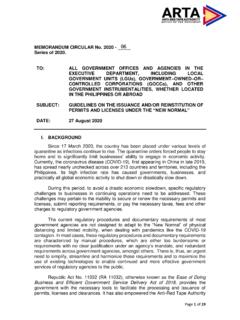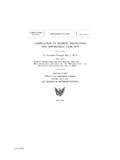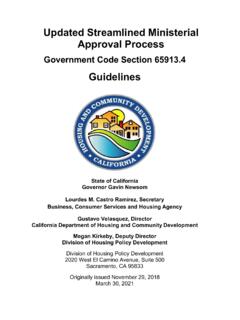Transcription of Revised Joint Memorandum Circular No.: 01 Series of 2021
1 1 Revised Joint Memorandum Circular No.: 01 Series of 2021 SUBJECT: REVISING AND EXPANDING Joint Memorandum Circular NO. 01, S. 2020 OR THE STREAMLINED GUIDELINES FOR THE ISSUANCE OF PERMITS, LICENSES, AND CERTIFICATES FOR THE CONSTRUCTION OF SHARED PASSIVE TELECOMMUNICATIONS TOWER INFRASTRUCTURE (PTTIs) DATE: 11 JUNE 2021 SECTION 1. BACKGROUND On 23 July 2020, Joint Memorandum Circular No. 1, Series of 2020 was executed for the purpose of prescribing the streamlined processes and requirements as to application for permits, licenses and clearances for the construction of Shared Passive Telecommunications Tower Infrastructure (PTTIs) that will be constructed by Mobile Network Operators (MNOs) duly authorized by the National Telecommunications Commission (NTC) and Independent Tower Companies (ITCs) duly registered with the DICT, in order to facilitate the accelerated rollout of telecommunication infrastructure and service projects.
2 On 11 September 2020, Republic Act No. 11494 or the Bayanihan to Recover As One Act was enacted to provide for COVID-19 response and recovery interventions and provide mechanisms to accelerate the recovery and bolster the resiliency of the Philippine Economy, provide funds therefore, and for other purpose. Section 4 (ii) provides for COVID-19 Response and Recovery Interventions for the acceleration of the deployment of critical Information and Communications Technology Infrastructure (ICT) particularly additional cell towers, equipment, software, and wireless technologies throughout the country to address the need for digital connectivity, internet speed and stability, and Cybersecurity in E-Commerce, E-Government, online learning, and telecommuting in order to sufficiently meet the significant additional shift of the general public to online services and platforms and to home and mobile communication units for doing work from home, for completing commercial and other transactions, for convening meetings and conducting conferences and seminars/webinars.
3 And for obtaining educational instruction during the COVID-19 pandemic through the Department of Information and Communications Technology (DICT). 2 One of the measures to be undertaken under the No. 11494 is the temporary suspension of requirements to secure permits and clearances for the construction of telecommunications and internet infrastructure. The subsequent passage of No. 11494 brought about various interpretations as to the applicability of JMC No. 1 s. 2020, particularly on the provisions that are in conflict with No. 11494. Hence, this JMC is executed in order to harmonize the provisions of No. 11494 and JMC No. 1 s. 2020 and provide further guidelines on the implementation of JMC No.
4 1 s. 2020. SECTION 2. Section 2 of JMC No. 1 s. 2020 is hereby Revised to read as follows: SECTION 2. PURPOSE The overall objectives of this Joint Memorandum Circular (JMC) are the following: To revise and expand Joint Memorandum Circular No. 01, Series of 2020 in order to harmonize its provisions with the provisions of Republic Act No. 11494 or the Bayanihan to Recover As One Act . To provide further guidelines on the implementation of JMC No. 1 s. 2020, prescribing streamlined processes and requirements as to application for permits, licenses, and clearances for the construction of PTTI s, whether shared or exclusive, that will be constructed by Public Telecommunications Entities (PTEs) and Independent Tower Companies (ITCs) duly registered with the Department of Information and Communications Technology (DICT), in order to facilitate the accelerated rollout of telecommunication infrastructure and service projects.
5 SECTION 3. Section 3 of JMC No. 1 s. 2020 is hereby Revised to read as follows: SECTION 3. LEGAL COMPLIANCE Section 301 of Republic Act No. 6541, as Revised by Presidential Decree No. 1096, otherwise known as the National Building Code of the Philippines (NBCP) provides that: No person, firm or corporation, including any agency or instrumentality of the government, shall erect, construct, alter, repair, move, convert or demolish any building or structure or cause the same to be done without first obtaining a building permit therefor from the Building Official assigned in the place were the subject building is located or the building work is to be done. Section 309 of the NBCP provides that: No building or structure shall be used or occupied and no change in the existing use or occupancy classification of a building or structure or portion thereof shall be made until the Building Official has issued a Certificate of Occupancy thereof as provided in this Code.
6 3 The DPWH National Building Code Development Office Memorandum Circular No. 1, s. 2005 provides that: Until a Building Official (BO) is fully deputized by the Secretary of Public Works and Highways for a particular local government, the official designated by the concerned local chief executive through a Special Order to be responsible for the enforcement of the provisions of the NBCP as well as of its IRR shall serve as BO for said local government. Republic Act No. 9485, as amended by Republic Act , otherwise known as the Ease of Doing Business and Efficient Government Service Delivery Act of 2018 , provides for the following: Section 10 mandates the automatic approval of applications for, or extension of licenses, clearances, permits and authorizations if such have not been approved by a government office within the prescribed processing time, provided that all required documents have been submitted and all required fees and charges have been paid.
7 Section 11 prescribes specifically for LGUs, the use of a unified form, the organization of a physical or electronic business one-stop shop ( BOSS ), automation of business permitting and licensing systems ( BPLS ), integration of barangay clearances with the LGU business permitting system, one-time release of ancillary permits together with the business permit. Section 12 adopts streamlined procedures for getting the Fire Safety and Inspection Certificate (FSIC) that includes prescribed processing times and other directives for the Bureau of Fire Protection (BFP) to comply with. Section 15 provides for the expedited processing and approval of licenses, clearances, permits, certifications or authorizations for the installation and operation of telecommunication, broadcast towers, facilities, equipment and service.
8 Section 1 of Administrative Order No. 23 s. 2020, titled Eliminating Overregulation to Promote Efficiency of Government Processes , states that: Section 1. Elimination of Overregulation. All national government agencies covered by Section 3 of RA No. 9485, as amended, are directed to hasten the reform of their processes in order to eliminate overregulation. They shall retain only such steps, procedures and requirements as may be necessary to fulfill their legal mandates and policy objectives. All processes in excess thereof, including those which are redundant or burdensome to the public, shall be deemed manifestations of overregulation and shall be removed accordingly. DILG-DICT-DPWH-DTI Joint Memorandum Circular No.
9 2018-01, titled Guidelines in Streamlining the Processes for the Issuance of Building Permits and Certificates of Occupancy . 4 DILG Memorandum Circular No. 2019-177, titled Guidelines in the Integration of the Issuance of Barangay Clearance in the permitting Processes of Cities and Municipalities . DPWH National Building Code Development Office (NBCDO) Memorandum Circular No. 1, s. 2020, issued on 30 July 2020, provides for the Unified Application Forms for Building Permits and Certificates of Occupancy and Revised Prescribed Preformatted Building Permit and Certificate of Occupancy Forms. Section 4 (ii)(1) of No. 11494 otherwise known as Bayanihan to Recover As One Act provides that: (1) Temporary suspension of requirements to secure permits and clearances for the construction of telecommunications and internet infrastructure.
10 Except for the building permit issued by the Office of the Building Official pursuant to Presidential Decree No. 1096 or the National Building Code of the Philippines , as amended, and the height clearance permit from the Civil Aviation Authority of the Philippines (CAAP), no national or local permit or clearance shall be required in the construction, installation, repair, operation and maintenance of telecommunications and internet infrastructure by independent tower companies registered with the DICT, or holders of authority granted by the National Telecommunications Commission (NTC) to public telecommunication entities, for a period of three (3) years from the effectivity of this Act.





